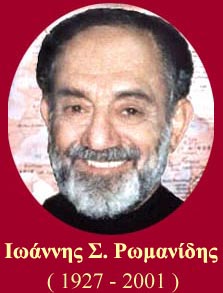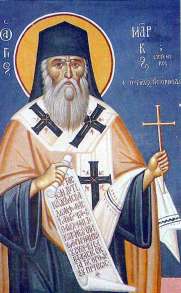ST. CYRIL'S "ONE PHYSIS OR HYPOSTASIS OF GOD THE LOGOS INCARNATE" AND CHALCEDON [ 1 ]
© John S. Romanides
ВЫСКАЗЫВАНИЕ СВЯТИТЕЛЯ КИРИЛЛА АЛЕКСАНДРИЙСКОГО "ОДНА ПРИРОДА ИЛИ ИПОСТАСЬ БОГА СЛОВА ВОПЛОЩЕННОГО" И ХАЛКИДОНСКИЙ СОБОР (IV ВСЕЛЕНСКИЙ СОБОР)
профессор доматики Фесаллоникского университета им. Аристотеля протопресвитер Иоанн Романидис

- [ Published in the Greek Orthodox Theological Review, vol. X, 2 Winter 1964-65 also Published in "Does Chalcedon Divide or Unite?" Edited by Paul Gregorios, William H. Lazereth, Nikos Nissiotis, WCC, Geneva 1981, pp. 50-75. Also published in "Christ in East and West," edited by Paul R. Fries and Tiran Nersoyan, Mercer University Press, 1987, pp.15-34.]
TABLE OF CONTENTS
- Introduction
- PART I
- PART II
- DISCUSSION
[ Return ]
Introduction
 Both Chalcedonian and non-Chalcedonian Orthodox accept St. Cyril as the chief Patristic exponent of Orthodox Christology. Yet both accuse each other of not remaining completely faithful to Cyril.
Both Chalcedonian and non-Chalcedonian Orthodox accept St. Cyril as the chief Patristic exponent of Orthodox Christology. Yet both accuse each other of not remaining completely faithful to Cyril.
 The non-Chalcedonian Orthodox reject the Council of Chalcedon and accuse it of Nestorianism because it accepted the Tome of Leo, two natures after the union, and allegedly omitted from its definition of faith such Cyrillian expressions as One Nature of God the Logos Incarnate, hypostatic or natural union, and from two natures or from two One Christ. The failure of Chalcedon to make full use of Cyril's Twelve Chapters, to condemn the Christology of Theodore, and its acceptance of Theodoret and Ibas throws suspicion on it. Then there is the weighty accusation that the very act of composing a new definition of the faith contradicted the decision of Ephesus (431) which decreed that, It is unlawful for anyone to bring forward or to write or to compose another Creed besides that determined by the Holy Fathers assembled with the Holy Spirit in Nicaea. [ 2 ]
The non-Chalcedonian Orthodox reject the Council of Chalcedon and accuse it of Nestorianism because it accepted the Tome of Leo, two natures after the union, and allegedly omitted from its definition of faith such Cyrillian expressions as One Nature of God the Logos Incarnate, hypostatic or natural union, and from two natures or from two One Christ. The failure of Chalcedon to make full use of Cyril's Twelve Chapters, to condemn the Christology of Theodore, and its acceptance of Theodoret and Ibas throws suspicion on it. Then there is the weighty accusation that the very act of composing a new definition of the faith contradicted the decision of Ephesus (431) which decreed that, It is unlawful for anyone to bring forward or to write or to compose another Creed besides that determined by the Holy Fathers assembled with the Holy Spirit in Nicaea. [ 2 ]
 The Chalcedonian Orthodox, on the other hand, believe that it was Cyril's Christology which was not only fully accepted at Ephesus, but served as the basis of all judgments concerning Christology at Ghalcedon in 451 and especially at Constantinople in 553. In spite of its obvious deficiencies the Tome of Leo is adequately Orthodox, definitely not Nestorian, and was accepted only as a document against Eutyches, but again only in the light of and in subordination to the synodical letters (especially the Twelve Chapters) of Cyril to Nestorius and John of Antioch, as we shall see. The terminology and faith of Cyril were fully accepted, although the Eutychian heresy, the chief concern of the Council, called for some adaptation to the new situation. One may point out that the acceptance of the Chalcedonian definition was no different from the acceptance of Cyril's letters at Ephesus. Neither the one act nor the other can be considered as a composition of a new Creed. They are both interpretations and clarifications of the Nicaean faith m the light of modern circumstances. It is noteworthy that even Cyril had to defend himself against the accusation that he accepted a new Creed in his reconciliatory correspondence with John of Antioch. [ 3 ] Theodoret and Ibas were restored to the episcopacy because they accepted Ephesus I and especially the Twelve Chapters, which acceptance is in itself a condemnation of what they had written about and against Cyril and his anathemas. The Fifth Ecumenical Council of 553 anathematized the writings of Theodoret and Ibas against Cyril and the very person of Theodore, the Father of Nestorianism.
The Chalcedonian Orthodox, on the other hand, believe that it was Cyril's Christology which was not only fully accepted at Ephesus, but served as the basis of all judgments concerning Christology at Ghalcedon in 451 and especially at Constantinople in 553. In spite of its obvious deficiencies the Tome of Leo is adequately Orthodox, definitely not Nestorian, and was accepted only as a document against Eutyches, but again only in the light of and in subordination to the synodical letters (especially the Twelve Chapters) of Cyril to Nestorius and John of Antioch, as we shall see. The terminology and faith of Cyril were fully accepted, although the Eutychian heresy, the chief concern of the Council, called for some adaptation to the new situation. One may point out that the acceptance of the Chalcedonian definition was no different from the acceptance of Cyril's letters at Ephesus. Neither the one act nor the other can be considered as a composition of a new Creed. They are both interpretations and clarifications of the Nicaean faith m the light of modern circumstances. It is noteworthy that even Cyril had to defend himself against the accusation that he accepted a new Creed in his reconciliatory correspondence with John of Antioch. [ 3 ] Theodoret and Ibas were restored to the episcopacy because they accepted Ephesus I and especially the Twelve Chapters, which acceptance is in itself a condemnation of what they had written about and against Cyril and his anathemas. The Fifth Ecumenical Council of 553 anathematized the writings of Theodoret and Ibas against Cyril and the very person of Theodore, the Father of Nestorianism.
 The non-Chalcedonian Orthodox have been for centuries accusing the Chalcedonian Orthodox of being Nestortans. On the other hand, the Chalcedonians have been accusing the non-Chalcedonians of either being monophysites (which for them means believers in one ousia in Christ) or of a one-sided insistence on Cyrillian terminology to the exclusion of Cyril's own acceptance of two natures in the confession of faith of john of Antioch which brought about the reconciliation of 433. This one-sidedness was adopted by the Ephesine Council of 449 and rejected by the Council of Chalcedon. It should also be noted that the Flavian Endemousa Synod of 448 was one-sided in its use of and insistence on the Cyrillian terminology of the 433 reconciliation to the near exclusion of Cyril's normal way of speaking about the incarnation. From Chalcedon and especially from Constantinople II it is clear that the Chalcedonians without compromise allow for variations in terms which express the same faith. On the non-Chalcedonian side Severus of Antioch seems to be the only one who comes close to Cyril's acceptance of two natures tei theoriai monei after the union, a position adopted at Chalcedon and clearly stated in the definition or anathemas of the Fifth Ecumenical Council.
The non-Chalcedonian Orthodox have been for centuries accusing the Chalcedonian Orthodox of being Nestortans. On the other hand, the Chalcedonians have been accusing the non-Chalcedonians of either being monophysites (which for them means believers in one ousia in Christ) or of a one-sided insistence on Cyrillian terminology to the exclusion of Cyril's own acceptance of two natures in the confession of faith of john of Antioch which brought about the reconciliation of 433. This one-sidedness was adopted by the Ephesine Council of 449 and rejected by the Council of Chalcedon. It should also be noted that the Flavian Endemousa Synod of 448 was one-sided in its use of and insistence on the Cyrillian terminology of the 433 reconciliation to the near exclusion of Cyril's normal way of speaking about the incarnation. From Chalcedon and especially from Constantinople II it is clear that the Chalcedonians without compromise allow for variations in terms which express the same faith. On the non-Chalcedonian side Severus of Antioch seems to be the only one who comes close to Cyril's acceptance of two natures tei theoriai monei after the union, a position adopted at Chalcedon and clearly stated in the definition or anathemas of the Fifth Ecumenical Council.

